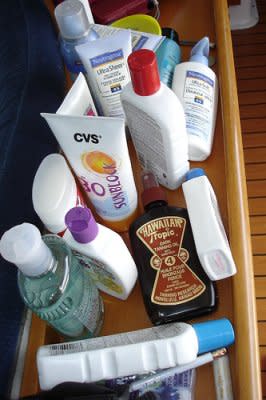Shocking sunscreen report is misleading, skin expert says

After reading the Environmental Working Group's 2010 Sunscreen Review released this week, I did what millions of others probably did -- I panicked. According to the EWG, only a few dozen of hundreds of sunscreens on the market are both safe to use and protect us like they should. After plugging in the two products I use regularly on myself and my kids, only one made the cut. The other was on the "avoid" list because it contained "harmful chemicals" and supposedly didn't live up to its claims of screening out harmful UVA rays.
More from The Stir: EWG's Children's Sunscreen Review -- 5 Top Picks
Five hundred sunscreens on the market with some of the latest sun-blocking and skin-care innovations and only 39 are okay to use. Really?
Dermatologist Dr. Zoe Draelos, a consulting professor at the Duke University School of Medicine and spokesperson for the American Academy of Dermatology, who also tests sunscreen products in her laboratory, applauds the EWG for looking at the safety and effectiveness of sunscreens, but feels the group is making unfair "sweeping generalizations."
More from The Stir: 10 Safe Sunscreens That Really Work
"I think it's very sad," Draelos says. "A lot of their sunscreen recommendations are based on very old technology, and some of the best sunscreens on the market have newer chemicals that are very effective. A lot of their opinions are not keeping pace with technology and an understanding of the science of these formulations. The nuances of sunscreens are very important."
You also have to consider the source. The EWG is a research and advocacy group that tries to change public policy and industry standards, largely through consumer-friendly tools and databases similar to the sunscreen report. The EWG's critics, largely members of industry, have argued that it often over-exaggerates data to promote its political agenda, which it does explicitly through a separate lobbying group.
The bottom line is that the EWG favors minerals, natural ingredients, and not chemicals, and it would never recommend a product containing a man-made agent with "unknown" health effects. That's why you won't find sunscreens containing anything other than zinc and titanium, from brands such as Badger, California Baby, and Loving Naturals, on its list. Among its most hated ingredient: oxybenzone, an ingredient common to many sunscreens that in some studies has been linked to cell damage, aka cancer. But there's no consensus on that. Oxybenzone is also the least effective of available blockers at absorbing the full spectrum of UVA rays, the deeply penetrating ones linked to cancer and wrinkles.
More from The Stir: Do Chemical Sunscreens Work Better Than Mineral Blockers?
I don't like the idea of my body absorbing chemicals with unknown health effects either, but I dislike the idea of skin cancer even more, and as far as scientific proof goes now, the later risk outweighs the former. Plus, I don't like sunscreen with zinc. It leaves a whitish film and makes me look like Caspar. I prefer products with mexoryl -- a chemical. It works almost as well as zinc without the whitish tint.
And isn't sunscreen only truly effective if you actually wear it?
Draelos noted that zinc and titanium, when made into very small concentrations as is common for skin care products, can be absorbed by the body, as well. No one is sure what the long-term health effects from either of them is, either.
The other really awful sunscreen ingredient that the EWG alerts us about is retinoic acid and its derivatives, specifically retinol and retinyl palmitate. You've probably seen the anti-aging claims on may sunscreen products; these probably claim to contain "vitamin A." It's the same stuff that's in the prescription Retin-A.
The EWG suggests these ingredients could actually promote cancer more that help to stop it, but it doesn't go into a lot of detail on the exact connection between the two.
More from The Stir: Babies and Sunscreen Don't Mix: 8 Ways to Protect Baby from the Sun
Another misspoken claim, explains Draelos.
Retinol or Retin-A is a skin peeler -- it removes dead skin cells from the outer layer of the dermis, and by virtue of that, your body's ability to block cancer-causing UV rays is decreased. That's why people who use it are told to wear sunblock and to apply it only at night, because the sunlight deactivates it. In other words, it does nothing.
Retinyl palmitate, an anti-oxidant used strictly as a preservative to help the product retain its creaminess, is likely the retinol derivative found in these products, and it is completely safe, Draelos says. So, this supposed connection between retinol and cancer baffles her.
I wanted to know if I should continue using my current sunscreens and Draelos said yes. Despite the EWG's claims that products with really high SPFs drastically overstate their sun protection claims, Draelos still suggests a product of at least 50 or more.
More from The Stir: Common Sunscreen Mistakes and How to Avoid Them
Like the EWG, she agrees the FDA needs to get moving and develop a procedure for for measuring UVA rays. The agency has been working on this for years. Everyone seems to agree that we won't really know if the products are protecting us as well as they claim until then. Draelos says that will eliminate a lot of confusion the EWG has over many of these sunscreen issues.
Meantime, there's no good reason to stop doing what we've been doing.
"You're going to be fine," says Draelos, who despite all the critics has faith in sunscreen makers and the testing they put their products through. "These companies have a lot of resources riding on their products, customer service is important to them, and they want to be the leaders in this area for many years to come."
Did the EWG report scare you off your current sunscreen?
Written by Cynthia Dermody on CafeMom's blog, The Stir.
